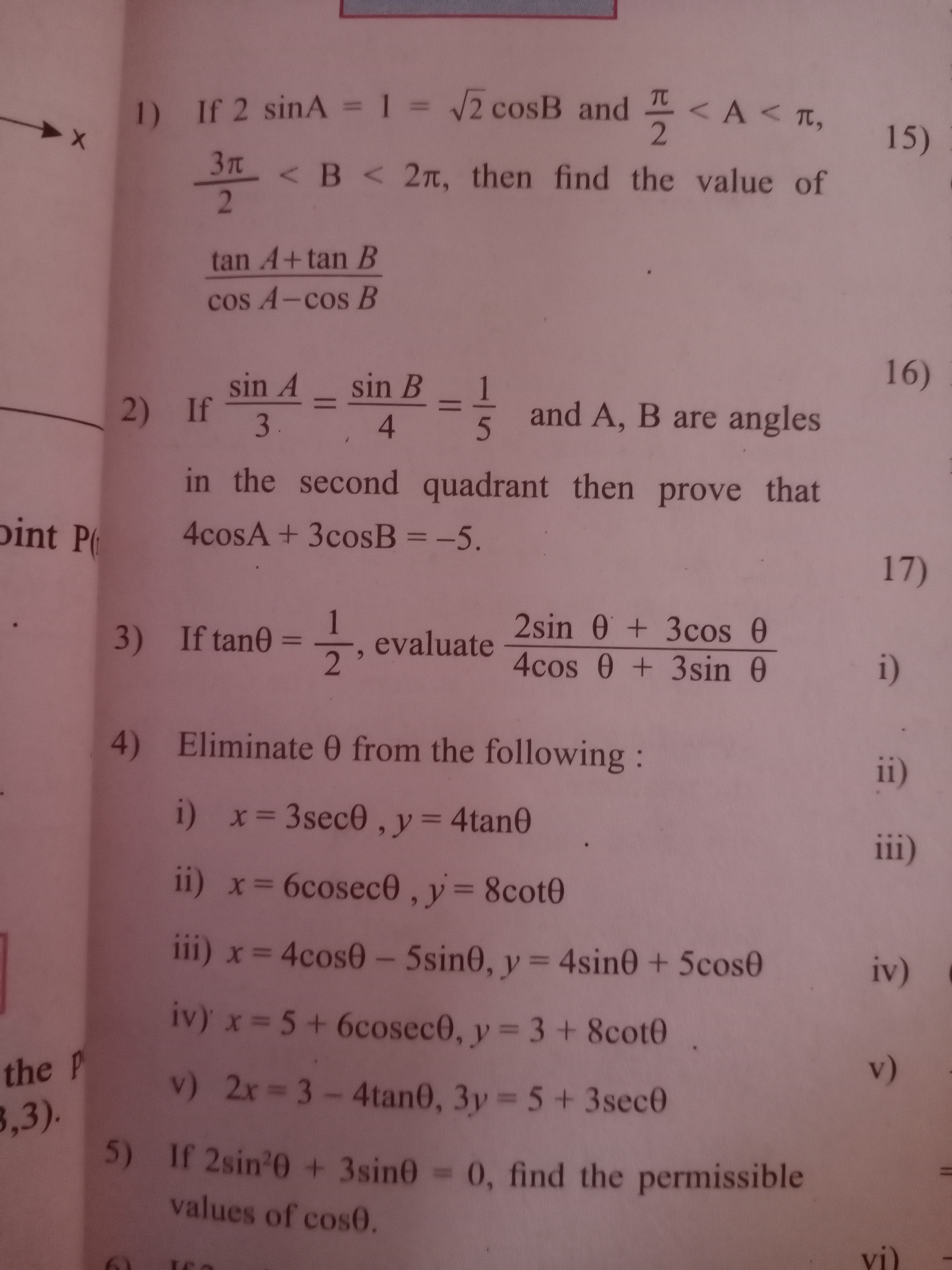1) If 2 sin A = 1 = √2 cos B and 3π/2 < B < 2π, then find the value of tan A + tan B / cos A - cos B. 2) If sin A / 3 = sin B / 4 = 1/5 and A, B are angles in the second quadrant,... 1) If 2 sin A = 1 = √2 cos B and 3π/2 < B < 2π, then find the value of tan A + tan B / cos A - cos B. 2) If sin A / 3 = sin B / 4 = 1/5 and A, B are angles in the second quadrant, then prove that 4 cos A + 3 cos B = -5. 3) If tan θ = 2, evaluate 2 sin θ + 3 cos θ / 4 cos θ + 3 sin θ. 4) Eliminate θ from the following: i) x = 3 sec θ, y = 4 tan θ, ii) x = 6 cosec θ, y = 8 cot θ, iii) x = 4 cos θ - 5 sin θ, y = 4 sin θ + 5 cos θ, iv) x = 5 + 6 cosec θ, y = 3 + 8 cot θ, v) 2x = 3 - 4 tan θ, 3y = 5 + 3 sec θ. 5) If 2 sin² θ + 3 sin θ = 0, find the permissible values of cos θ.

Understand the Problem
The question consists of multiple mathematical problems related to trigonometric identities and equations, requiring step-by-step solutions to find specific values or prove certain equations.
Answer
The simplified answer is $$ \frac{\frac{1}{\sqrt{3}} + 1}{\frac{\sqrt{3}}{2} - \frac{\sqrt{2}}{2}}. $$
Answer for screen readers
The final value is
$$ \frac{\frac{1}{\sqrt{3}} + 1}{\frac{\sqrt{3}}{2} - \frac{\sqrt{2}}{2}}. $$
This simplifies numerically as needed.
Steps to Solve
- Use Given Trigonometric Identity
We start with the equation (2 \sin A = 1 = \sqrt{2} \cos B). This implies:
$$ \sin A = \frac{1}{2} $$ $$ \cos B = \frac{1}{\sqrt{2}} $$
- Determine Angles A and B
From ( \sin A = \frac{1}{2} ),
- The angles in ( \left(\frac{\pi}{2}, \pi\right) ) satisfying this are ( A = \frac{\pi}{6}, \frac{5\pi}{6}. )
From ( \cos B = \frac{1}{\sqrt{2}} ),
- The angles in ( \left(\frac{3\pi}{2}, 2\pi\right) ) satisfying this are ( B = \frac{7\pi}{4}, \frac{5\pi}{4}. )
- Apply The Given Range for B
The condition ( \frac{3\pi}{2} < B < 2\pi ) narrows it down:
- Therefore, ( B = \frac{7\pi}{4}. )
- Calculate ( \tan A + \tan B )
We can find ( \tan A ) and ( \tan B ):
- For ( A = \frac{\pi}{6} ):
$$ \tan A = \tan\left(\frac{\pi}{6}\right) = \frac{1}{\sqrt{3}} $$
- For ( B = \frac{7\pi}{4} ):
$$ \tan B = \tan\left(\frac{7\pi}{4}\right) = 1. $$
So,
$$ \tan A + \tan B = \frac{1}{\sqrt{3}} + 1. $$
- Calculate ( \cos A - \cos B )
Next, find the cosines for ( A ) and ( B ):
- For ( A = \frac{\pi}{6} ):
$$ \cos A = \cos\left(\frac{\pi}{6}\right) = \frac{\sqrt{3}}{2} $$
- For ( B = \frac{7\pi}{4} ):
$$ \cos B = \cos\left(\frac{7\pi}{4}\right) = \frac{\sqrt{2}}{2}. $$
Then,
$$ \cos A - \cos B = \frac{\sqrt{3}}{2} - \frac{\sqrt{2}}{2}. $$
- Calculate the Final Expression
Now, substitute into:
$$ \frac{\tan A + \tan B}{\cos A - \cos B} $$
This becomes:
$$ \frac{\frac{1}{\sqrt{3}} + 1}{\frac{\sqrt{3}}{2} - \frac{\sqrt{2}}{2}}. $$
Now calculate the values.
The final value is
$$ \frac{\frac{1}{\sqrt{3}} + 1}{\frac{\sqrt{3}}{2} - \frac{\sqrt{2}}{2}}. $$
This simplifies numerically as needed.
More Information
This problem works through trigonometric identities and angle identities. It's important to use the correct quadrant in which angles lie based on given conditions.
Tips
- Failing to determine the correct quadrant for angles A and B.
- Not simplifying expressions correctly after substitution.
AI-generated content may contain errors. Please verify critical information